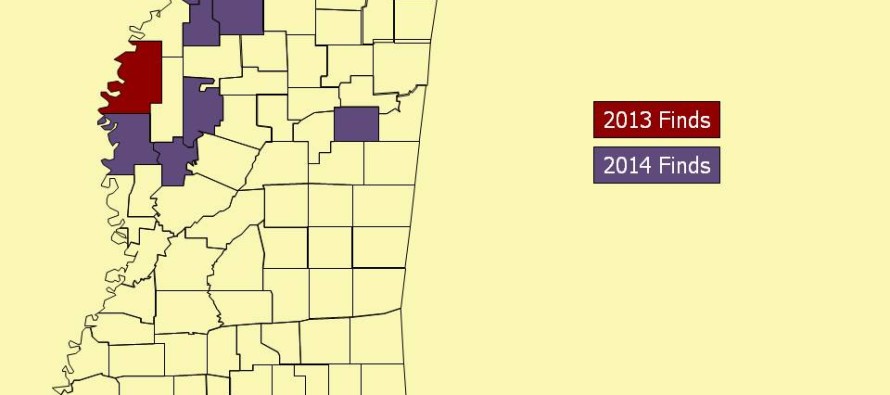White Sugarcane Aphid Update and Impact on Midge Applications

Populations of the white sugarcane aphid are expanding and increasing across the state. We have confirmed the presence of white sugarcane aphid in grain sorghum in 7 counties in Mississippi (Fig 1) and there are likely more. The counties where white sugarcane aphids have been found include Bolivar, Washington, Humphreys, Quitman, Panola, Tunica, and Oktibbeha.
We will continue to survey grain sorghum fields across the state throughout the year and the map will be updated regularly. If you think you have white sugarcane aphid in a county other than those currently listed, please let us know.
There are several species of aphids that can occur on grain sorghum. We had a post a couple of weeks ago that goes into detail about identification with some good pictures.
He also talked about management of white sugarcane aphid in grain sorghum. Based on all of the information that we have received from Texas and Louisiana, this aphid is much more difficult to control than other aphid species that occur in grain sorghum. For that reason, we currently have a Section 18 for the use of Transform to manage sugarcane aphid in grain sorghum (Details are in the previous post).
The last sentence of that article is what I want to focus on for this article. That last sentence is : “Word of Caution: Disruptive sprays such as pyrethroids for midges may flare aphids, so scout closely if you make a midge spray.” Populations of sugarcane aphid are absolutely the worst following a pyrethroid application. Angus sprayed some sugarcane aphids in Starkville that were at a very low level with 1 oz. of Karate. Within a week, those aphids blew up to damaging levels.
Below are some pictures that we took of sugarcane aphids this week from around the Delta. You can click on each one to view the larger image. The first picture shows a comparison of corn leaf aphid (left) to white sugarcane aphid (right). This picture was from a field in Humphreys County. I am fairly confident that this field had not been previously sprayed with a pyrethroid because it was not heading and a pyrethroid would have controlled the corn leaf aphids. You will also notice in that the white sugarcane aphid colony is fairly small and we could find several small colonies scattered across the field.
All of the other pictures were taken in fields that were at various stages of heading and may have been sprayed with a pyrethroid for midge. In those fields, the colonies are much larger and were much easier to find.
Because we have not dealt with this pest in the past, we don’t have a lot of definitive answers about how to manage the crop to avoid an infestation or how to manage them once they are in the field. We do, however, have some ideas about ways to minimize the infestations.
Manage Sorghum Midge Accordingly: Scout for midge and try to avoid making automatic midge applications with a pyrethroid. At this point, we don’t know if eliminating a pyrethroid spray for midge will keep you from having a treatable infestation of white sugarcane aphid, but we do know that a pyrethroid application will make the aphids a lot worse.
Scouting for midge is fairly easy, but can be tedious and time consuming. Our threshold says to spray when you average 1 per head at 20-30% bloom.  The picture on the left shows 3 levels of bloom in grain sorghum. Grain sorghum starts blooming at the top of the head, so the head on the left is at approximately 30% bloom. In other words, the upper one third of that head is blooming. Over the next 2-4 days, the blooms will move down the head ending up like the picture on the far right where the yellow anthers are visible at the bottom of the head. This is 100% bloom.
The picture on the left shows 3 levels of bloom in grain sorghum. Grain sorghum starts blooming at the top of the head, so the head on the left is at approximately 30% bloom. In other words, the upper one third of that head is blooming. Over the next 2-4 days, the blooms will move down the head ending up like the picture on the far right where the yellow anthers are visible at the bottom of the head. This is 100% bloom.
So basically, when the yellow anthers are present anywhere from the top one third of the head down, then those heads are susceptible to damage from midge.
Visual observation of the heads is the best way to scout for midge. I like to use a clear plastic bag. You can gently slip the bag over an individual panicle and shake the plant. If any midge are present, they will fly up and you can easily see them flying around in the bag. It is just as easy to stand in one place and gently thump a couple of stalks to flush them off the head.
In terms of management, low to mid rates of pyrethroids have always been the products of choice. However, it appears that white sugarcane aphids will be a game changer. As mentioned previously, pyrethroids will flare the aphids. Other options in Mississippi include dimethoate and Lannate. Although we can’t be sure, we expect that dimethoate will be less likely to flare aphids than a pyrethroid.
Finally, scout fields regularly for both midge and white sugarcane aphid. If you find bright yellow aphids in any of your grain sorghum fields, please let one of us know so that we can update the distribution maps.









